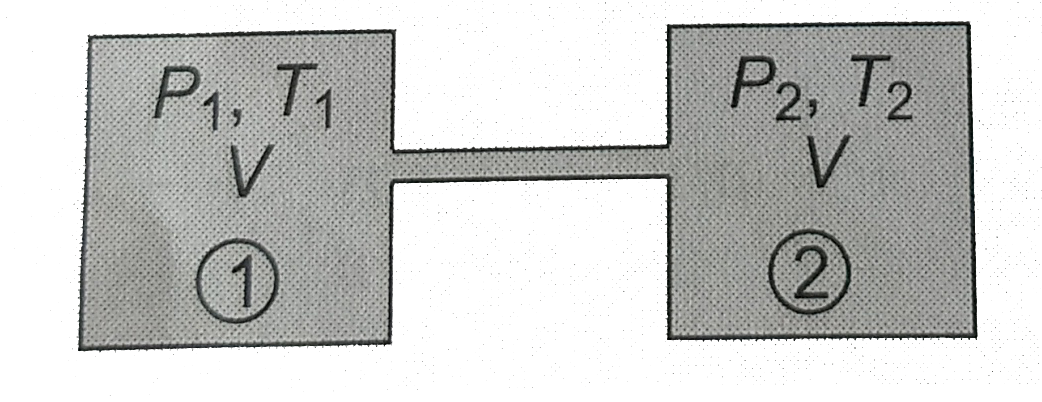A vessel A has volume V and a vessel B has volume 2V. Both contain some water which has constant volume. The pressure in the space above water is p_(a) for vessel A and p_(b) for vessel B.
(a)pa=pb
(b)pa=2pb
(c)pb=2pa
(d)pb=4pa
The correct Answer is:A
Step by step video, text & image solution for A vessel A has volume V and a vessel B has volume 2V. Both contain some water which has constant volume. The pressure in the space above water is p_(a) for vessel A and p_(b) for vessel B. by Physics experts to help you in doubts & scoring excellent marks in Class 11 exams.
Updated on:21/07/2023Topper's Solved these Questions
- KINETIC THEORY OF GASESBook:HC VERMAChapter:KINETIC THEORY OF GASESExercise:Objective 2
Explore 7 Videos
- KINETIC THEORY OF GASESBook:HC VERMAChapter:KINETIC THEORY OF GASESExercise:Exercises
Explore 62 Videos
- KINETIC THEORY OF GASESBook:HC VERMAChapter:KINETIC THEORY OF GASESExercise:Short Answer
Explore 14 Videos
- INTRODUCTION TO PHYSICSBook:HC VERMAChapter:INTRODUCTION TO PHYSICSExercise:Exercises
Explore 19 Videos
- LAWS OF THERMODYNAMICSBook:HC VERMAChapter:LAWS OF THERMODYNAMICSExercise:Short Answer
Explore 15 Videos
Similar Questions
A vessel of volume 3V contains a gas at pressure 4P0 and another vessel of volume 2V contains same gas at pressure 1.5P0. Both vessels have same temperature. When both vessels are connected by a tube of negligible volume, the equilibrium is IP0, where I is an integer. Find the value of I.
View SolutionA vessel of volume V is evacuated by means of a piston air pump. One piston stroke captures the volume v0. The pressure in the vessel is to be reduced to (1n) of its original pressure ,P0. If the process is assumed to be isothermal and air is considered an ideal gas, the number of strokes needed in the process is
View Solution
Knowledge Check
Two vessels A and B have volumes V and 4V respectively Both vessels contain some water The pressure in the space above water is P1 in vessel A and P2 in vessel B at temperature T which one is correct ? .
AP1=P2B4P1=P2CP1=4P2DP1=16P2When a gas is heated in a vessel of constant volume , the pressure increases because
AThe average force per impact of a molecule on a wall of the vessel increasesBMolecules hit the walls more frequentlyCMolecules collide with each other more frequentlyDThe number of molecules per unit volume of the gas increasesTwo vessels of the same volume contain the same gas at same temperature. If the pressure in the vessels is in the ratio of 1 : 2, then
Athe ratio of the average kinetic energy is 1 : 2Bthe ratio of the root mean square velocity is 1 : 1Cthe ratio of the average velocity is 1 : 2Dthe ratio of number of molecules is 1 : 2
Two vessels A and B with rigid walls containing ideal gases. The pressure, temperature and the volume are P1,T1,V in the vessel A and P2,T2,V in the vessel B. The vessels are now connected through a small tube. In equilibrium, pressure P and temerature T becomes same in two vessels. Find the value of P/T.

View SolutionA gas is enclosed in a vessel of volume V at a pressure P. It is being pumped out of the vessel by mean of a piston-pump with a stroke volume. v. What is the final pressure in the vessel after 'n' strokes of the pump ? Assume temperature reamains constant.
View SolutionA vessel of volume V0 contains an ideal gas at pressure p0and temperature T. Gas is continuously pumped out of this vessel at a constant volume-rate dVdt=r keeping the temperature constant, The pressure inside the vessel. Find (a) the pressure of the gas as a function of time,(b) the time taken before half the original gas is pumped out.
View SolutionA closed vessel A having volume V contains N2 at pressure P and temperature T. another closed vessel B having the same volume V contains. He at the same pressure P. but temperature 2T. The ratio of masses of N2 and He in the vesses A and B is
View SolutionA vessel has nitrogen gas and water vapours at a total pressure of 1 atm. The partial pressure of water vapours is 0.3 atm. The contents of this vessel are transferred to another vessel having one third of the capacity of original volume, completely at the same temperature, the total pressure of the system in the new vessel is
View Solution